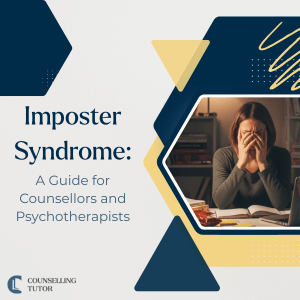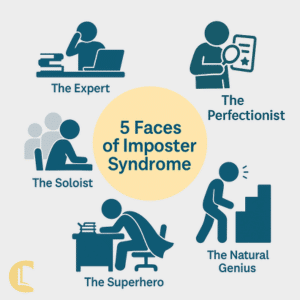Your Free Handout
Overcoming Imposter Syndrome
The following article is based on a lecture that can be found in our CPD Lecture Library.
As a counsellor or psychotherapist, you may find yourself grappling with self-doubt despite having a strong academic background and clinical experience. This internal voice that whispers “I’m not good enough” is a hallmark of imposter syndrome, a phenomenon that disproportionately affects high-achieving professionals – including those in the helping professions.
Imposter syndrome can significantly impact your confidence, decision-making, and client relationships. Understanding and addressing this experience is essential not only for your well-being but also for modelling self-acceptance and authenticity for your clients.

Overcoming Imposter Syndrome
From this exploration, you will be able to:

Imposter syndrome is defined as the internal experience of believing that you are not as competent as others perceive you to be, despite objective successes. According to Kolligian and Sternberg (1991), it involves persistent self-doubt and a fear of being exposed as a fraud, particularly among high achievers.
It is worth noting that imposter syndrome is not recognised as a distinct psychological disorder in the Diagnostic and Statistical Manual of Mental Disorders (DSM-5). Instead, it is best understood as a common psychological experience that can co-occur with other difficulties such as anxiety and depression.
This is not classified as a psychological disorder in the DSM-5, yet it remains a widespread and impactful internal experience, especially among those working in emotionally demanding professions like counselling.
Valerie Young (2011) identified five personality archetypes prone to imposter syndrome:

These patterns may resonate with how you or your clients experience professional challenges.
Imposter syndrome is often intensified by specific environmental and psychological conditions, including:
Understanding these risk factors is key to building compassion for yourself and others navigating this experience.

Imposter syndrome can subtly – or dramatically – shape how you show up in your work:
Practitioners may downgrade their career choices to avoid perceived exposure or over-invest in training to feel competent. Others may expect failure despite a proven track record, or self-impose unnecessary limits that restrict growth and opportunity. Over time, this erodes confidence and can lead to burnout, isolation, or stalled practice development.
Overcoming Imposter Syndrome
Imposter syndrome thrives in secrecy, perfectionism, and over-analysis. When we critique ourselves mid-task, performance tends to decline – not because we lack skill, but because our attention is divided. Simultaneously, we may ignore praise or reassurance from others, assuming that their positive feedback doesn’t apply to us.
This creates a vicious cycle: poor concentration leads to mistakes or delays, which reinforce negative self-beliefs and prevent us from acknowledging progress or seeking support. Often, this is compounded by isolation – believing we are alone in these feelings, even when others quietly experience the same.
Recognising and disrupting these loops, particularly through techniques such as cognitive behavioural therapy (CBT), can help restore clarity, performance, and confidence. This is particularly useful when imposter syndrome co-occurs with anxiety or depression, for which CBT is already an evidence-based practice.
Before we move on to practical strategies, it’s helpful to acknowledge that imposter syndrome is a widespread and natural experience, not a flaw or a failing. Our brains are evolutionarily wired to be more alert to threats (like social rejection or failure) than opportunities. This means feelings of not being good enough are often more about perceived danger than objective reality.
Normalising these thoughts – rather than judging them – can be a therapeutic act in itself, especially in supervision or therapy with counsellors who feel they should “know better” than to doubt themselves. As Cuddy (2015) reminds us, if so many of us feel like impostors, perhaps the problem lies not in our abilities, but in how we see ourselves.

In therapeutic work, it’s the latter that creates genuine presence and relational safety. Embracing your authentic self, flaws and all, can enhance your connection with clients and reduce the dissonance that fuels imposter syndrome.
Evidence-based strategies include:
If we all only knew how many of us felt like impostors… we’d have to conclude either: (1) We’re all impostors and none of us know what we’re doing, or (2) Our self-assessments are way off.
Try these questions in supervision, personal development, or client work:
Overcoming Imposter Syndrome
Imposter syndrome in counselling involves persistent self-doubt and the fear of being exposed as a fraud, even when a practitioner is qualified and competent. It can lead to over-preparing, avoiding visibility, and undercharging, ultimately impacting confidence and client relationships.
The five types are the Perfectionist, who focuses on flaws and rarely feels satisfied; the Expert, who feels they must know everything before starting; the Natural Genius, who struggles when tasks aren’t immediately easy; the Soloist, who believes asking for help shows inadequacy; and the Superhero, who overworks to hide feelings of inferiority.
Effective strategies include cognitive reframing, gratitude practice, mindful reflection, seeking support, and embracing authenticity. These approaches help break the cycle of self-doubt and restore confidence in professional identity.
Imposter syndrome thrives in silence and self-judgement. But within a reflective, compassionate, and grounded therapeutic environment, it can be reframed as a shared human experience rather than a personal failing. For you as a practitioner, this means allowing yourself to be imperfect, to grow, and to claim the space you’ve earned through lived experience and professional commitment.
Working with imposter syndrome – whether in yourself or your clients – requires a gentle unravelling of unhelpful beliefs and the conscious choice to live and work from a place of being, not just doing.
Ahmed, A. et al. (2020). Why is there a higher rate of impostor syndrome among BIPOC? Across The Spectrum of Socioeconomics, 1(2), 1–17.
Bravata, D. M. et al. (2020). Prevalence, Predictors, and Treatment of Impostor Syndrome: A Systematic Review. Journal of General Internal Medicine. Available from: https://pmc.ncbi.nlm.nih.gov/articles/PMC7174434/
Brown, B. (2022). The Gifts of Imperfection. Minnesota: Hazelden.
Cuddy, A. (2015). Presence: Bringing Your Boldest Self to Your Biggest Challenges. New York: Little, Brown.
Kolligian, J. Jr & Sternberg, R. J. (1991). Perceived fraudulence in young adults: Is there an ‘imposter syndrome’? J Pers Assess. 56(2), 308–326.
Young, V. (2011). The Secret Thoughts of Successful Women: Why Capable People Suffer from the Impostor Syndrome and How to Thrive In Spite of It. New York: Random House.
Counselling Tutor provides trusted resources for counselling students and qualified practitioners. Our expert-led articles, study guides, and CPD resources are designed to support your growth, confidence, and professional development.
👉 Meet the team behind Counselling Tutor
Notice any broken link or issues with this resource? Kindly let us know by email
Email us